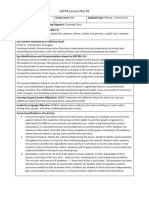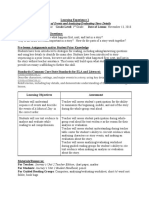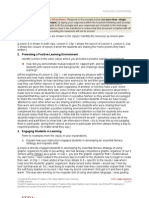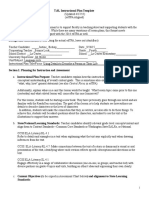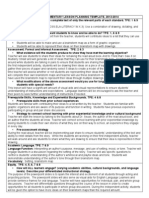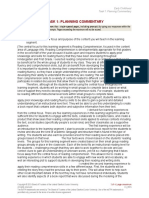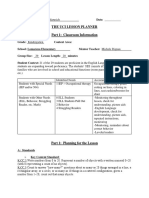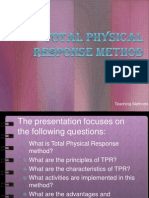0%(1)0% found this document useful (1 vote)
1K viewsEdtpa Lesson Plans
Edtpa Lesson Plans
Uploaded by
api-254587554Copyright:
© All Rights Reserved
Available Formats
Download as DOCX, PDF, TXT or read online from Scribd
Edtpa Lesson Plans
Edtpa Lesson Plans
Uploaded by
api-2545875540%(1)0% found this document useful (1 vote)
1K views15 pagesOriginal Title
edtpa lesson plans
Copyright
© © All Rights Reserved
Available Formats
DOCX, PDF, TXT or read online from Scribd
Share this document
Did you find this document useful?
Is this content inappropriate?
Copyright:
© All Rights Reserved
Available Formats
Download as DOCX, PDF, TXT or read online from Scribd
Download as docx, pdf, or txt
0%(1)0% found this document useful (1 vote)
1K views15 pagesEdtpa Lesson Plans
Edtpa Lesson Plans
Uploaded by
api-254587554Copyright:
© All Rights Reserved
Available Formats
Download as DOCX, PDF, TXT or read online from Scribd
Download as docx, pdf, or txt
You are on page 1of 15
edTPA Multiple Subject
LESSON PLANNER: Monday
Classroom Information
Grade: _3____ Content Area/Class Title: Mathematics
Group Size: _25_____ Lesson Length: ___50____ minutes
Classroom Context:
Total enrolled: __25___
Second language learners: Emerging___ Expanding_3__ Bridging_22__ RFEP___
Special needs students (IEP, 504, RSP, GATE):
o Describe specific accommodations for each of these students
Spanish language learners provided with oral explanation of directions and paired with a native
Spanish speaker.
Planning for the Lesson
A: Standards
i. Common Core Math Content Standard: CCSS.Math.Content.3.NF.A.3a Understand two
fractions as equivalent (equal) if they are the same size, or the same point on a number line.
ii. Key Common Core ELA (if appropriate):
iii. Key ELD Standard (if appropriate):
B. Objectives
i. Learning Objective:
Cognitive Behavior: Students will complete an exploration to find equivalent fractions
using a number line. After showing different strategies, students will be able to visually
compare fractions on a number line.
Student Learning Focus: Students will learn the definition of equivalent. Students will
also be able to successfully find equivalent fractions on a number line and know that the
same point on a number line means two fractions are equivalent.
ii. Language Objective (transfer this from "Incorporating Academic Language"):
The students will be able to justify if two fractions are equivalent or not on a number line using
the word equivalente. The students will actively participate in whole class
instruction/discussion as well as pair-shares and partner work to practice mathematical
discourse and language.
C. Assessments:
i. Informal assessment strategies you will use during class
During the exploration with the number line I will walk around and assess student
understanding of the basic fraction concepts. I will write down any good strategies I see and
I will have these students share. The students will have various opportunities throughout the
lesson to pair-share. The slicing squares activity will be a we do as a class trying to
decide what the fractions are, I will call on random students using the popsicle sticks and
will ask for student participation using thumbs up and thumbs down.
ii. Written assessment you will use to determine, for each individual student, to what extent
they have met your learning objectives.
As a you do each student will complete a worksheet individually. They will also be
writing in their math journals the definition for equivalent and an example.
D. Lesson Resources/Materials (e.g., handouts, manipulatives, special supplies):
Each student has a math journal
Students will have a fraction flipbook (they completed the previous week), if needed to they could
refer back to.
I will have two clipart cutouts of cookies.
Each student will have a slicing squares and Fracciones Equivalentes worksheet
Instructional Sequence - Engaging Students in the Learning Process
Optional: Starter and/or Homework Discussion (___ min.)
Introduction (_10_ min.): Describe how you will make connections to prior knowledge, let students know
what the focus of the lesson is, and tap into their experiences and interests.
Pre-assessment. The students take out their homework from Thursday (a number line with fraction
diagrams under each point of the number line) and on the board the teacher writes 1/2 __ 2/4, 4/6 __
2/3, 1/2__1/3, and 3/6__4/8. The teacher tells the students Hoy vamos a trabajar ms con los smbolos
que aprendimos la semana pasada. Alguien me puede decir cuales son los smbolos que usamos
cuando estamos hablando de mayor que, menor que, e igual a? A volunteer is called to draw the signs
on the board. Then the teacher tells the students Quiero que en sus cuadernos escriben los smbolos
que van entre los fracciones y si necesitan pueden usar las rectas numricas como visual, tambin
pueden trabajar en grupo.
Body of the Lesson (__30__ minutes): Describe step-by-step what the teacher and the students will be
doing during the lesson.
Launch (_15__ min.) Whole group instruction at desks. The teacher tell them that they will be get to
the number lines but will first go through slicing squares activity with the class asking questions like
Que fraccin esta sombreada? (1/2) then when a line is drawn through asking Ahora contando las
partes iguales, Que fraccin esta sombreada? (2/4) During the lesson the students will learn the word
eqivalentes and the definition. The teacher will ask Quien me puede decir que significa
equivalente? Student will share what they think and the teacher will rephrase, Equivalente significa
igual. Las fracciones son equivalentes cuando nombran la misma parte del entero. Fracciones
equivalentes tienen el mismo valor, aunque parezcan diferentes. (This definition will also be written
on poster paper, and talking the class through it the teacher will draw pictures of equivalent fractions ie
and 2/4 using both shapes and number lines). The teacher will have two cut outs of cookies and will
first tear into 2 and give to two students. Then will tear into four pieces, will give two pieces to two
students ask Que fraccin de galleta tiene cada estudiante? Es el mismo tamao que antes? Son
partes iguales? After the students answer and realize that having and 2/4 is the same amount tthe
teacher will say,Vimos que un medio y dos cuatros son igual, podemos decir que un medio es
equivalente a dos cuatros. Clarification also has to be made and said, Quiero que notan que cuando
estamos comparando fracciones equivalentes tienen que tener el mismo tamao del entero, por eso
pudimos comparar las fracciones en la rectas numricas porque son del mismo tamao Ask students
to recall how when comparing fraction (shapes) last week they saw that the (entero) shapes have to be
the same size.
Explore (_15___ min.) Students will go back to the homework and teacher will demonstrate how a
number line can be used to find equivalent fractions, by looking at the same point of the number line.
After giving the students time to explore and experience solving the problem for themselves the
teacher stops the class and says, Quiero ensenarles como yo resolvera el primero. Entonces Donde
esta un medio en mi recta numrica? Y donde esta dos cuartos? Siguen con migo en sus rectas
numricas, cuando estamos comparando un medio con dos cuatros que notan? Quiero que circulan en
su recta numrica un medio y dos cuatros, que notan de los dos fracciones un medio es menor que dos
cuatros, mayor que o igual? The students will then be given additional time to try to solve the rest of
the problems with their group.
Orchestrating Discussion / Summarize (__5__ min.) The students will individually complete a
worksheet in class. They have already completed this work sheet for homework (with four number
lines) but this time they will be asked to fill it out and use this to find the equivalent fractions. After
five minutes of exploration the teacher will ask students to share what equivalent fractions they found.
Homework (if you are assigning homework, what will it be?): Students will complete Fracciones
Equivalentes worksheet at home.
Closure (_5___minutes):
The teacher asks the students what they have noticed while working with finding equivalent fractions
on a number line. Discussion can be initiated by the teacher saying, Vimos que si tenemos dos rectas
numericas del mismo tamano que si dos fracciones estan en el mismo punto en la recta numerica son
equivalentes. Students will be asked to share anything else they learned this day.
Incorporating Academic Language
1. Describe the cognitive task(s) related to the content learning objective.
Students need to use the vocabulary (equivalente) to describe two fractions on the same point of
two different number lines (of the same size). They will have to explain why they are the same
size.
2. What language function do you want to systematically address in your lesson plan that will
scaffold students to stronger disciplinary discourse?
A language function that is essential for student understanding is categorizing. Students will begin
to compare to fractions and notice if a fraction is greater than, equal to, or less than the other. They
will be using the sentence frame __es equivalente a __porque____. Or __no es equivalente
a___porque___es___.
3. What is/are the language objective(s) for your lesson? (Note: be sure to copy and paste this into
the top of the lesson planner.)
The students will be able to justify if two fractions are equivalent or not on a number line using the
word equivalente. The students will actively participate in whole class instruction/discussion as
well as pair-shares and partner work to practice mathematical discourse and language.
4. What linguistic demand(s) related to your language function are you going to explicitly "teach"
your students? (e.g., compound sentence, introductory clause, sequence words, genre cue words)
The word equivalente will be introduced to the students, both in mathematical terms and in terms
that applies to them in real life.
5. What key vocabulary will students need during this lesson?
New to this lesson: Equivalente, valor
Previously taught but need continued support: desigual
Previously learned: simbolos, recta numerica, comparar, entero, partes iguales
6. What learning "interval" will you include in your lesson plan to support your Language Objective?
Instruction Guided Practice Independent Practice
Teacher models using the
vocabulary words and
sentence frames
When students answer
questions orally they are to
use the sentence frames when
comparing fractions.
Students will write the
sentence frames in their
journals.
edTPA Multiple Subject
LESSON PLANNER: Tuesday
Classroom Information
Grade: _3____ Content Area/Class Title: Mathematics
Group Size: _25_____ Lesson Length: ___50____ minutes
Classroom Context:
Total enrolled: __25___
Second language learners: Emerging___ Expanding_3__ Bridging_22__ RFEP___
Special needs students (IEP, 504, RSP, GATE):
o Describe specific accommodations for each of these students
Spanish language learners provided with oral explanation of directions and paired with a native Spanish
speaker.
Planning for the Lesson
A: Standards
i. Common Core Math Content Standard: CCSS.Math.Content.3.NF.A.3b Recognize and generate
simple equivalent fractions, e.g., 1/2 = 2/4, 4/6 = 2/3. Explain why the fractions are equivalent,
e.g., by using a visual fraction model.
ii. Key Common Core ELA (if appropriate):
iii. Key ELD Standard (if appropriate):
B. Objectives
i. Learning Objective:
Cognitive Behavior: Students will use fraction manipulatives to find equivalent fractions. After
exploration students will have practice sharing their answers using the provided sentence
frame.
Student Learning Focus: Students will be able to successfully find equivalent fractions using
linear fraction manipulatives. They will be able to justify their answers orally and with a visual
model.
iii. Language Objective (transfer this from "Incorporating Academic Language"):
The students will be able to justify if two fractions are equivalent or not using manipulatives.
The students will actively participate in whole class instruction/discussion as well as pair-
shares and partner work to practice mathematical discourse and language.
C. Assessments:
i. Informal assessment strategies you will use during class: Listening to pair-shares, thumbs
up or thumbs down to demonstrate content understanding and engagement, I will also begin
to keep anecdotal notes of students learning and progress.
ii. Written assessment you will use to determine, for each individual student, to what extent
they have met your learning objectives.
Students will write in their math journals and individually complete a worksheet in class.
D. Lesson Resources/Materials (e.g., handouts, manipulatives, special supplies):
Each student has a math journal
Each student will have a set of fraction tiles.
Students will have a fraction flipbook, if needed to they could refer back to.
Each student will have a Fracciones Equivalentes worksheet
Instructional Sequence - Engaging Students in the Learning Process
Optional: Starter and/or Homework Discussion (___ min.)
Introduction (_10_ min.): Sitting at carpet. The teacher tells the students, Ahora vamos a seguir
trabajando con fracciones equivalentes. Dile a tu par que significa equivalente. Refer to the definition
on the poster paper after the students share. Point out how the word equivalente is a cognate. Review
how to find fraction equivalencies with a number line and what that means (review where the fractions
go on a number line as a class), Ayer vimos que cuando tenemos una recta numrica del mismo
tamao, podemos comparar el punto, y si esta en el mismo parte que nos dice? Entonces cuales
fracciones son equivalentes Have students practice using the sentence frame by pair sharing ___es
eqivalente a ___porque___. Call on students to share using the sentence frame. Tell students that they
will be doing the same concept except with fraction tiles Hoy vamos a ver otra manera para encontrar
fracciones equivalentes, ayer trabajamos con rectas numricas hoy vamos a usar las tiras de fracciones.
Body of the Lesson (_30___ minutes): Describe step-by-step what the teacher and the students will be
doing during the lesson.
Launch (_15__ min.) Whole group instruction. Go over procedure and rules for using manipulatives
Voy a demostrar como usar los, ie tengo un medio y quiero encontrar las fracciones equilvantes, show
and ask un medio es equivalente a un octavo, a un cuatro. Using the overhead projector will show
students how to find the equivalent fractions of (2/4, 4/8). During the modeling the teacher will
continue to go over the fraction concepts and will ask questions like Es mayor/menor? etc. A
sentence frame will be written on the board for students to use: ____es equivalente a____.Tell them
that at first they might not find equivalencies but that it is okay for them to experienment and they will
discover the fractions evnturally. Trabajando juntos con su par, a buscar otras fracciones equivlantes a
un medio, saquen su cuaderno de matematicas y cuando encuentren fracciones equivlantes van a
escribirlos en su cuadenero usando la oracion. Ask if they students have any questions on what is
asked of them. The teacher will have student helpers pass out fraction manipulatives, and students will
be asked to begin. After five minutes the teacher will say, Vamos a compartir los fracciones
equivlantes que han encontrado and will ask students to share equivalent fractions they found, they
will share out and be prompted to use the sentence frame. The teacher will show the equivlante
fractions as the students share out using the projector and will write them all down.
Explore (__15__ min.) Students will take out the fraction flipbook and the barras de fracciones
worksheet they completed last week. Model using some of the equivlanet fractions they have found for
by using both of those other materilas. The students are told that they could use the fraction
manipulatives, or the other two materials, and work independently to find the fraction equivalencies of
1/3 (2/6, 3/9, 4/12). They will be asked to write in their journals using the sentence frame. After 5-10
minutes of exploration the teacher will call students to share one equivalent fraction, they will explain
the equivalent fractions using the sentence frame. Ask the class How are the fraction strips similar to
fractions on a number line? What are equivalent fractions? etc
Orchestrating Discussion / Summarize (__5__ min.) Model how to complete number one on a
worksheet. The students will individually complete the worksheet in class, they will find the fraction
equivalencies of the given numbers 2/3, 1/3, and 1/5. On the worksheet they will draw and shade in
the equivalent fractions (in the pre-drawn boxes, but still paying attention to partes iguales) as they
find the equivalent fractions. Will be told that they can use the manipulatives and the fraction flip book
if need to. Teacher will walk around to monitor, and may pull a small group for additional support.
Review as class, especially number 2.
Homework (if you are assigning homework, what will it be?): A worksheet where the instructions are
Sombrea las fracciones equivalentes y complete el numerador que falta.
Closure (__5____minutes):
The teacher asks the students what they have noticed while working with finding equivalent fractions
with fraction strips. Ask Qu patrones observas en el numerador de las fracciones equivalentes?
Qu patrones observas en el denominador de las fracciones equivalentes?
Incorporating Academic Language
1. Describe the cognitive task(s) related to the content learning objective.
Students need to use the vocabulary to describe the fraction equivalencies of a given fraction. They
will have to explain why fractions are equivalent or not using the sentence frame.
2. What language function do you want to systematically address in your lesson plan that will scaffold
students to stronger disciplinary discourse?
A language function that is essential for student understanding is categorizing. Students will begin
to compare to fractions and notice if a fraction is greater than, equal to, or less than the other. They
will be using the sentence frame __es equivalente a __porque____. Or __no es equivalente
a___porque___es___.
3. What is/are the language objective(s) for your lesson? (Note: be sure to copy and paste this into the
top of the lesson planner.)
The students will be able to justify if two fractions are equivalent or not using manipulatives.
The students will actively participate in whole class instruction/discussion as well as pair-
shares and partner work to practice mathematical discourse and language.
4. What linguistic demand(s) related to your language function are you going to explicitly "teach" your
students? (e.g., compound sentence, introductory clause, sequence words, genre cue words):
Equivalente.
5. What key vocabulary will students need during this lesson?
New to this lesson: Equivalente
Previously taught but need continued support: desigual, mismo valor
Previously learned: simbolos, recta numerica, comparar, entero, partes iguales
6. What learning "interval" will you include in your lesson plan to support your Language Objective?
Instruction Guided Practice Independent Practice
Teacher models using the
vocabulary words and
sentence frames
When students answer
questions orally they are to
use the sentence frames when
comparing fractions.
Students will write the
sentence frames in their
journals.
edTPA Multiple Subject
LESSON PLANNER: Wednesday
Classroom Information
Grade: _3____ Content Area/Class Title: Mathematics
Group Size: _25_____ Lesson Length: ___50____ minutes
Classroom Context:
Total enrolled: __25___
Second language learners: Emerging___ Expanding_3__ Bridging_22__ RFEP___
Special needs students (IEP, 504, RSP, GATE):
o Describe specific accommodations for each of these students
Spanish language learners provided with oral explanation of directions and paired with a native Spanish
speaker.
Planning for the Lesson
A: Standards
i. Common Core Math Content Standard: CCSS.Math.Content.3.NF.A.3b Recognize and
generate simple equivalent fractions, e.g., 1/2 = 2/4, 4/6 = 2/3. Explain why the fractions are
equivalent, e.g., by using a visual fraction model
ii. Key Common Core ELA (if appropriate):
iii. Key ELD Standard (if appropriate):
B. Objectives
i. Learning Objective:
Cognitive Behavior:
Cognitive Behavior: Students will use fraction manipulatives to find equivalent fractions. After
exploration students will have practice sharing their answers using the provided sentence
frame.
Student Learning Focus: Students will be able to successfully find equivalent fractions using
linear fraction manipulatives. They will be able to justify their answers orally and with a visual
model.
ii. Language Objective (transfer this from "Incorporating Academic Language"):
The students will be able to justify if two fractions are equivalent or not using manipulatives. The
students will actively participate in whole class instruction/discussion as well as pair-shares and
partner work to practice mathematical discourse and language.
C. Assessments:
iii. Informal assessment strategies you will use during class: Listening to pair-shares, thumbs
up or thumbs down to demonstrate content understanding and engagement, I will also keep
anecdotal notes of students learning and progress.
iv. Written assessment you will use to determine, for each individual student, to what extent
they have met your learning objectives.
Students will write in their math journals and will complete a worksheet in class with their group, yet
each individual will have their own copy.
D. Lesson Resources/Materials (e.g., handouts, manipulatives, special supplies):
Each student has a math journal
Each table group will have a predetermined (differentiated) worksheet with a fraction they musyt
find the equivalencies for
Each student will have a set of fraction circular tiles.
Students will have a fraction flipbook, if needed to they could refer back to.
I will have two clipart cutouts of cookies.
Instructional Sequence - Engaging Students in the Learning Process
Optional: Starter and/or Homework Discussion (___ min.)
Introduction (_10_ min.): Sitting at carpet. The teacher has the students pair share what equivalent
means, will call on a student to share using the popsicle sticks. To elaborate the teacher will ask, Que
notamos ayer con los fracciones eqivalentes? Review the fractions and equivalencies with a
numberline and with fraction tiles, students will practice comparing fractions using the sentence frame,
students will be called on my random to share. Share examples of student homework from the prior
night of students who have already made the connection that they can also draw the fractions as a
circle underneath the number line. Tell students that they will be doing the same concept except with
circles, Ya saben dos estrategias para encontrar y visualizer fracciones eqiuvalentes, hoy vamos a
trabajar usando la estrategia usando los circulos. tell them to note the patterns.
Body of the Lesson (_30___ minutes): Describe step-by-step what the teacher and the students will be
doing during the lesson.
Launch (_15__ min.) Explain how to use the materials to solve number on their worksheet,
demonstrate how to use the circle outline to draw the equivalent fractions of as well as answer using
the sentence frame. The teacher explains how this will be group work and for number two each group
will have a different fraction they will need to find the equilvalent fractions for. Go over how to work
in groups and how to make sure everyone is participating by asking questions like Que piensas___?
Por que dices eso? Puedes anadir algo? Etc The teacher will have student helpers pass out fraction
manipulatives, and using the overhead projector will show students how to find the equivalent
fractions of using the circle manipulatives (2/4, 4/8). During the modeling the teacher will continue
to go over the fraction concepts and will ask questions like Es mayor que/menor que? etc
Explore (__15__ min.) Students will use the fraction manipulatives and work with their table group to
find the fraction equivalencies of two fractions (every group will have at least one different fraction
set, there are four sets that are organized by increasing difficulty level). They will have the sentence
frame ___es equivalente a_____. Each student is required to fill out their own individual paper. The
teacher will walk around and monitor student work, ensuring that they are working well together and
using the manipulatives correctly. After 5minutes of exploration the teacher will call on each group
and one student will come to the front and show the fraction equivalencies on the overhead projector,
they will explain the equivalent fractions using the sentence frame.
Orchestrating Discussion / Summarize (__5__ min.) The students will individually complete a
worksheet in class. Will be told that they can use the manipulatives if need to. Teacher will walk
around to monitor, and may pull a same group for additional support.
Homework (if you are assigning homework, what will it be?): A worksheet with the instructions:
Sombrea las partes iguales de la fraccin para mostrar la ecuacin. Luego escriba el numerador que
falta.
Closure (__5____minutes):
The teacher asks the students Qu patrones observas en el numerador de las fracciones equivalentes?
Qu patrones observas en el denominador de las fracciones equivalentes?. The teacher also asks and
records any new strategies the students discovered.
Incorporating Academic Language
1. Describe the cognitive task(s) related to the content learning objective.
Students need to use the vocabulary to describe the fraction equivalencies of a given fraction. They
will have to explain why fractions are equivalent or not using the sentence frame.
2. What language function do you want to systematically address in your lesson plan that will scaffold
students to stronger disciplinary discourse?
A language function that is essential for student understanding is categorizing. Students will begin
to compare to fractions and notice if a fraction is greater than, equal to, or less than the other. They
will be using the sentence frame __es equivalente a __porque____. Or __no es equivalente
a___porque___es___.
3. What is/are the language objective(s) for your lesson? (Note: be sure to copy and paste this into the
top of the lesson planner.)
The students will be able to justify if two fractions are equivalent or not using manipulatives.
The students will actively participate in whole class instruction/discussion as well as pair-
shares and partner work to practice mathematical discourse and language.
4. What linguistic demand(s) related to your language function are you going to explicitly "teach" your
students? (e.g., compound sentence, introductory clause, sequence words, genre cue words):
Equivalente.
5. What key vocabulary will students need during this lesson?
New to this lesson:
Previously taught but need continued support: desigual, mismo valor, patrones
Previously learned: simbolos, recta numerica, comparar, entero, partes iguales
6. What learning "interval" will you include in your lesson plan to support your Language Objective?
Instruction Guided Practice Independent Practice
Teacher models using the
vocabulary words and
sentence frames
When students answer
questions orally they are to
use the sentence frames when
comparing fractions.
Students will write the
sentence frames in their
journals.
edTPA Multiple Subject
LESSON PLANNER: Thursday
Classroom Information
Grade: _3____ Content Area/Class Title: Mathematics
Group Size: _25_____ Lesson Length: ___50____ minutes
Classroom Context:
Total enrolled: __25___
Second language learners: Emerging___ Expanding_3__ Bridging_22__ RFEP___
Special needs students (IEP, 504, RSP, GATE):
o Describe specific accommodations for each of these students
Spanish language learners provided with oral explanation of directions and paired with a native Spanish
speaker.
Planning for the Lesson
A: Standards
i. Common Core Math Content Standard: CCSS.Math.Content.3.NF.A.3d Compare two
fractions with the same numerator or the same denominator by reasoning about their size.
Recognize that comparisons are valid only when the two fractions refer to the same whole.
Record the results of comparisons with the symbols >, =, or <, and justify the conclusions,
e.g., by using a visual fraction model.
ii. Key Common Core ELA (if appropriate):
iii. Key ELD Standard (if appropriate):
B. Objectives
i. Learning Objective:
Cognitive Behavior: Students will complete an exploration to find equivalent fractions using more
abstract methods such as benchmark fractions (1/2) and noticing patterns with the numerators and
denominators. Students will be able to compare fractions using the symbols <,=,> and will be able to
justify if they are equivalent or not.
Student Learning Focus: Students will be able to successfully compare and find equivalent fractions
using new strategies, will be able to justify answer using a visual model.
iii. Language Objective (transfer this from "Incorporating Academic Language"):
The students will be able to justify if two fractions are equivalent or not using benchmark fractions,
looking at patterns, and/or using a visual model. The students will actively participate in whole
class instruction/discussion as well as pair-shares and partner work to practice mathematical
discourse and language.
C. Assessments:
v. Informal assessment strategies you will use during class: Listening to pair-shares, thumbs
up or thumbs down to demonstrate content understanding and engagement, I will also keep
anecdotal notes of students learning and progress.
vi. Written assessment you will use to determine, for each individual student, to what extent
they have met your learning objectives.
The students will complete an activity with their partner and will chart their answer on a
class poster.
D. Lesson Resources/Materials (e.g., handouts, manipulatives, special supplies):
Each student has a math journal
Students will have a fraction flipbook, if needed to they could refer back to.
I will have a premade chart and premade post-its with differentiated fractions (one for each pair)
Each student will have a worksheet with two blank rectangles (same size) and two blank number
lines from 0-1.
Instructional Sequence - Engaging Students in the Learning Process
Optional: Starter and/or Homework Discussion (___ min.)
Introduction (_20_ min.): Sitting at carpet. Review the previous fraction concepts. Tell students that
they will be learning how to find equivalent fractions by just looking at the number and not drawing a
figure. The teacher goes over the different ways to compare fractions (this is also written on chart
paper)
1. If the numerator is the same, compare the denominator
> 1/8
2. If the denominator is the same, compare the numerator
3/10 < 8/10
3. Compare to landmark fraction, such as
4/10 <
Because 4/10 needs one more tenth to become a half.
Body of the Lesson (_30___ minutes): Describe step-by-step what the teacher and the students will be
doing during the lesson.
Launch (__20_ min.) Give each student pair a post-it note with a fraction on it. Have a poster with the
title Equivalent Fractions: How to tell if a fraction is bigger than or smaller than And have two
large boxes on both sides with the title Bigger than on one side and Smaller than on the other.
Explore (_10___ min.) Students will complete the following worksheet with their partner, they can use
manipulatives if needed. Teacher will monitor and assist as needed.
Orchestrating Discussion / Summarize (_10___ min.) After the students had time to discuss with their
partner where their fraction goes, call each group up one by one and they stick it where they think it
belongs.
Homework (if you are assigning homework, what will it be?):
Closure (___5___minutes):
The teacher asks the students what additional strategies they have noticed (ie how many more do they
need to reach one whole, etc.)
Incorporating Academic Language
1. Describe the cognitive task(s) related to the content learning objective.
Students need to use the vocabulary to describe the fraction equivalencies of a given fraction. They
will have to explain why fractions are equivalent or not using the sentence frame.
2. What language function do you want to systematically address in your lesson plan that will scaffold
students to stronger disciplinary discourse?
A language function that is essential for student understanding is categorizing. They will be using
the sentence frame __es equivalente a __porque____. Or __no es equivalente
a___porque___es___.
3. What is/are the language objective(s) for your lesson? (Note: be sure to copy and paste this into the
top of the lesson planner.)
The students will be able to justify if two fractions are equivalent or not using benchmark fractions,
looking at patterns, and/or using a visual model. The students will actively participate in whole
class instruction/discussion as well as pair-shares and partner work to practice mathematical
discourse and language.
4. What linguistic demand(s) related to your language function are you going to explicitly "teach" your
students? (e.g., compound sentence, introductory clause, sequence words, genre cue words):
Equivalente.
5. What key vocabulary will students need during this lesson?
New to this lesson: punto de referencia
Previously taught but need continued support: desigual, mismo valor, equivalentes
Previously learned: simbolos, recta numerica, comparar, entero, partes iguales
6. What learning "interval" will you include in your lesson plan to support your Language Objective?
Instruction Guided Practice Independent Practice
Teacher models using the
vocabulary words and
sentence frames
When students answer
questions orally they are to
use the sentence frames when
comparing fractions.
Students will write the
sentence frames in their
journals.
You might also like
- 321 Edtpa Phonics Lesson Plan Week 5Document6 pages321 Edtpa Phonics Lesson Plan Week 5api-436063485No ratings yet
- Edtpa Lesson Plan 2Document4 pagesEdtpa Lesson Plan 2api-465437662No ratings yet
- Edtpa Lesson PlansDocument16 pagesEdtpa Lesson Plansapi-28295791975% (4)
- Edtpa LessonsDocument12 pagesEdtpa Lessonsapi-279312232No ratings yet
- Edtpa Task 1 Part B - Plans For Learning SegmentDocument16 pagesEdtpa Task 1 Part B - Plans For Learning Segmentapi-302045878No ratings yet
- Spe 615 Lesson 2 PlanDocument3 pagesSpe 615 Lesson 2 Planapi-302304245No ratings yet
- Edtpa Literacy Task I Planning Linda HillardDocument5 pagesEdtpa Literacy Task I Planning Linda Hillardapi-270873656100% (1)
- Edtpa Context For LearningDocument4 pagesEdtpa Context For Learningapi-303432640100% (1)
- Assignment UED E PORTFOLIODocument25 pagesAssignment UED E PORTFOLIONur Aisyah100% (3)
- Edtpa Lesson Plan OneDocument4 pagesEdtpa Lesson Plan Oneapi-5963753780% (1)
- Ela Ed Tpa Lesson Plan For Advanced PracticumDocument6 pagesEla Ed Tpa Lesson Plan For Advanced Practicumapi-434492295No ratings yet
- Edtpa Task 1 LearningexperienceplansDocument10 pagesEdtpa Task 1 Learningexperienceplansapi-407875476No ratings yet
- Edtpa Lesson Plan 1Document2 pagesEdtpa Lesson Plan 1api-253443286100% (1)
- Edtpa Task 4Document14 pagesEdtpa Task 4api-3396969690% (1)
- Diff 510 - LP 1 Hairy Money Tiered by ComplexityDocument8 pagesDiff 510 - LP 1 Hairy Money Tiered by Complexityapi-299976291No ratings yet
- Task 1 Part B - Plans For Learning SegmentDocument7 pagesTask 1 Part B - Plans For Learning Segmentapi-308619027No ratings yet
- Mtennantassessment CommentaryDocument7 pagesMtennantassessment Commentaryapi-287349702No ratings yet
- Task 2 - Part B - Instruction CommentaryDocument6 pagesTask 2 - Part B - Instruction Commentaryapi-217962443No ratings yet
- Task 1 Part A - Context For Learning InformationDocument4 pagesTask 1 Part A - Context For Learning InformationmeaganLC100% (1)
- ABBHomeschoolCatalog2017 PDFDocument238 pagesABBHomeschoolCatalog2017 PDFAlexandra BonillaNo ratings yet
- Research ProposalDocument27 pagesResearch ProposalRiza Cutanda Isahac Alcuitas100% (2)
- Edtpa Lesson Plan 3Document4 pagesEdtpa Lesson Plan 3api-465437662No ratings yet
- Edtpa Lessons 123Document8 pagesEdtpa Lessons 123api-332436372No ratings yet
- EdTPA Lesson PlanDocument3 pagesEdTPA Lesson Plancdavila2100% (1)
- EdTPA SES Instruction Commentary Danielle WilsonDocument3 pagesEdTPA SES Instruction Commentary Danielle WilsonDanielle Wilson100% (1)
- edTPA-Task 1 Day 1Document2 pagesedTPA-Task 1 Day 1Chelsea Keeney100% (1)
- Part e Planning CommentaryDocument10 pagesPart e Planning Commentaryapi-2565505240% (1)
- Studentteaching Ela Edtpa LessonplanDocument8 pagesStudentteaching Ela Edtpa Lessonplanapi-301667326No ratings yet
- Lesson Plan #2Document6 pagesLesson Plan #2Jason DonaldsonNo ratings yet
- Edtpa Lesson PlansDocument12 pagesEdtpa Lesson Plansapi-34049548767% (3)
- Edtpa Lesson PlansDocument12 pagesEdtpa Lesson Plansapi-256801452No ratings yet
- Part E-Planning CommentaryDocument9 pagesPart E-Planning Commentaryapi-450875077No ratings yet
- Task 1 Planning CommentaryDocument5 pagesTask 1 Planning CommentaryJesse Skoubo100% (2)
- Edtpa Ell Instruction CommentaryDocument3 pagesEdtpa Ell Instruction Commentaryapi-439275675No ratings yet
- Edtpa Ell Planning CommentaryDocument7 pagesEdtpa Ell Planning Commentaryapi-439275675100% (1)
- Assessment Commentary 4Document13 pagesAssessment Commentary 4Shahadiar HabibNo ratings yet
- Task 1 Part C Instructional MaterialsDocument7 pagesTask 1 Part C Instructional Materialsapi-281206577No ratings yet
- Mccoy Task4g MaacDocument8 pagesMccoy Task4g Maacapi-332490117No ratings yet
- Ete 304 Lesson 5 EdtpaDocument2 pagesEte 304 Lesson 5 Edtpaapi-390728855No ratings yet
- Blease Task1 LPDocument20 pagesBlease Task1 LPapi-265863941No ratings yet
- 1st Grade ELA Lesson 3Document7 pages1st Grade ELA Lesson 3Jessica KalvaitisNo ratings yet
- Part e Literacy Planning CommentaryDocument9 pagesPart e Literacy Planning Commentaryapi-313700169No ratings yet
- Kayla Le - Task4 Partb Edtpa Ele MTH Learning Segment OverviewDocument3 pagesKayla Le - Task4 Partb Edtpa Ele MTH Learning Segment Overviewapi-605137853No ratings yet
- Edtpa Lesson Plans - EngermadiDocument3 pagesEdtpa Lesson Plans - Engermadiapi-716891078No ratings yet
- Lawson mt3 CommentaryDocument6 pagesLawson mt3 Commentaryapi-315324639No ratings yet
- Final EdtpaDocument12 pagesFinal Edtpaapi-311825873No ratings yet
- Smith Task3 AcDocument10 pagesSmith Task3 Acapi-270543710100% (1)
- Literacy Instruction Sept 2016Document6 pagesLiteracy Instruction Sept 2016api-288669283No ratings yet
- KeKwKKKT EdTPA EAL Planning CommentaryDocument6 pagesKeKwKKKT EdTPA EAL Planning Commentarydori.hauser100% (4)
- Lesson PlanDocument4 pagesLesson Planapi-512136633No ratings yet
- Kainrath Edtpa Early Childhood Planning Commentary RepairedDocument4 pagesKainrath Edtpa Early Childhood Planning Commentary Repairedapi-3091896210% (1)
- Edtpa Elementary Education Literacy - Context For LearningDocument3 pagesEdtpa Elementary Education Literacy - Context For Learningapi-299081358No ratings yet
- Baikd Part eDocument5 pagesBaikd Part eapi-317153463No ratings yet
- Maemorij PlanningcommentaryDocument6 pagesMaemorij Planningcommentaryapi-312080780No ratings yet
- 1 Lesson Plan SAMPLE EdTPA Task 1Document2 pages1 Lesson Plan SAMPLE EdTPA Task 1Callie ChiltonNo ratings yet
- Tpa 2 Designing InstructDocument23 pagesTpa 2 Designing Instructapi-464872834No ratings yet
- edtpa-ELEM-Math-context-for-learning-Tahtiana BrooksDocument3 pagesedtpa-ELEM-Math-context-for-learning-Tahtiana BrooksTahtiana BrooksNo ratings yet
- Mini Lesson Plan 7Document3 pagesMini Lesson Plan 7api-260889954100% (2)
- Task 3c - Special Education Assessment Commentary - MorganDocument7 pagesTask 3c - Special Education Assessment Commentary - Morganapi-240534906100% (1)
- Lesson Plan Template Elementary Education Edtpa 1Document4 pagesLesson Plan Template Elementary Education Edtpa 1api-535301747No ratings yet
- Tpa 2 - Designing InstructionDocument40 pagesTpa 2 - Designing Instructionapi-31773880791% (11)
- Mapping the Way from Teacher Preparation to edTPA® Completion: A Guide for Secondary Education CandidatesFrom EverandMapping the Way from Teacher Preparation to edTPA® Completion: A Guide for Secondary Education CandidatesNo ratings yet
- Lesson Planner MathDocument5 pagesLesson Planner Mathapi-307190488No ratings yet
- Experiential Learning Theory: A Dynamic, Holistic Approach To Management Learning, Education and DevelopmentDocument59 pagesExperiential Learning Theory: A Dynamic, Holistic Approach To Management Learning, Education and DevelopmentamiNo ratings yet
- Mobile Assisted Language Learning - Review of LiteratureDocument36 pagesMobile Assisted Language Learning - Review of LiteratureJuan GarciaNo ratings yet
- Non Technical, Non Scientific ApproachDocument10 pagesNon Technical, Non Scientific ApproachJennifer L. Magboo-Oestar75% (16)
- Beh - Thorndike - Student - S - Copy - PPT Filename - UTF-8''Beh - Thorndike - Student - S CDocument24 pagesBeh - Thorndike - Student - S - Copy - PPT Filename - UTF-8''Beh - Thorndike - Student - S CRevira EstorelNo ratings yet
- Pedagogy (MCQ Set-1) : Q1: When A Child 'Fails', It MeansDocument5 pagesPedagogy (MCQ Set-1) : Q1: When A Child 'Fails', It MeanshammadNo ratings yet
- Subsentential Level of GrammaDocument1 pageSubsentential Level of GrammaYannie Del RioNo ratings yet
- Web BasedDocument5 pagesWeb Basedapi-612362028No ratings yet
- Laura Machargo: Exceptional Student Education TeacherDocument4 pagesLaura Machargo: Exceptional Student Education Teacherapi-544613150No ratings yet
- Total Physical Response MethodDocument12 pagesTotal Physical Response MethodArely Benitez50% (2)
- Staff Development Strategy (2021 - 2022)Document13 pagesStaff Development Strategy (2021 - 2022)Oeun PenhNo ratings yet
- Life Skill EducationDocument3 pagesLife Skill EducationGreena BluesNo ratings yet
- Lara Integrated School: Minutes of The Meeting Faculty Meeting February 28, 2023Document2 pagesLara Integrated School: Minutes of The Meeting Faculty Meeting February 28, 2023Kimberly Ann ParasNo ratings yet
- Social Studies lp3Document4 pagesSocial Studies lp3api-579878396No ratings yet
- g67ml PDFDocument2 pagesg67ml PDFsoa nguyễn thị kimNo ratings yet
- Lesson Plan 2eDocument2 pagesLesson Plan 2eapi-340067048No ratings yet
- Good Practices Development ProgrammesDocument99 pagesGood Practices Development ProgrammesJohn VelardeNo ratings yet
- Gender and The Architectural Design ProcessDocument12 pagesGender and The Architectural Design ProcessMagriet SteynbergNo ratings yet
- Meetings 2 Getting Involved in Meetings Lesson PlanDocument3 pagesMeetings 2 Getting Involved in Meetings Lesson PlanAnaAleksicNo ratings yet
- Head Nursing ObjectivesDocument2 pagesHead Nursing ObjectivesNURSETOPNOTCHER100% (9)
- Module 3Document19 pagesModule 3Gero Mykel AponteNo ratings yet
- Lesson Plan Grade 7Document6 pagesLesson Plan Grade 7sandewi togatoropNo ratings yet
- Lac-Session-Increase Mean and PL of The First To Fourth Quarter by 2%Document8 pagesLac-Session-Increase Mean and PL of The First To Fourth Quarter by 2%Kairuz Demson AquilamNo ratings yet
- Doctor of Business Administration DBA HandbookDocument14 pagesDoctor of Business Administration DBA HandbookBrian JonesNo ratings yet
- Cognitive Domain-Arlie G. FresnidoDocument29 pagesCognitive Domain-Arlie G. FresnidoArlie Gelua FresnidoNo ratings yet
- My Job Application AdcDocument4 pagesMy Job Application Adcabel_kayelNo ratings yet
- IV Challenges in TeachingDocument6 pagesIV Challenges in Teachingกาวี กบาลสักNo ratings yet
- Effect of Affective FactorsDocument6 pagesEffect of Affective FactorsteeshuminNo ratings yet

